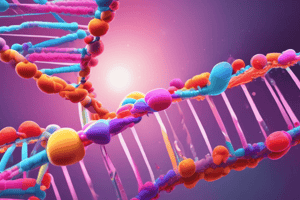Podcast
Questions and Answers
What is the role of RNA polymerase in protein synthesis?
What is the role of RNA polymerase in protein synthesis?
- It helps in the formation of peptide bonds between amino acids.
- It synthesizes mRNA using DNA as a template. (correct)
- It binds tRNA to the ribosome.
- It translates mRNA into proteins.
How many protein-coding genes are estimated to be in the human genome?
How many protein-coding genes are estimated to be in the human genome?
- 20,000 - 50,000 (correct)
- 50,000 - 100,000
- 100,000 - 200,000
- 10,000 - 20,000
What is the significance of codons in mRNA?
What is the significance of codons in mRNA?
- They help in the binding of mRNA to DNA.
- They act as a protective cap for the mRNA.
- They are the segments that code for specific amino acids. (correct)
- They specify the start codon for ribosome assembly.
What happens during the elongation phase of translation?
What happens during the elongation phase of translation?
Which of the following describes a mutation?
Which of the following describes a mutation?
What is produced at the end of the translation process?
What is produced at the end of the translation process?
What could be a consequence of a mutation in the DNA sequence during protein synthesis?
What could be a consequence of a mutation in the DNA sequence during protein synthesis?
What are the three components that make up a nucleotide in DNA?
What are the three components that make up a nucleotide in DNA?
Which nitrogen bases pair together in DNA?
Which nitrogen bases pair together in DNA?
What is the primary function of DNA in the context of genetic material?
What is the primary function of DNA in the context of genetic material?
What role does DNA play in immunology, according to the content?
What role does DNA play in immunology, according to the content?
In what form is genetic material found in prokaryotic cells?
In what form is genetic material found in prokaryotic cells?
How is the human genetic code quantified?
How is the human genetic code quantified?
What type of bonds form between complementary nitrogen bases in DNA?
What type of bonds form between complementary nitrogen bases in DNA?
Which of the following is NOT a function of DNA?
Which of the following is NOT a function of DNA?
Flashcards
DNA Structure
DNA Structure
DNA is a long, double-stranded molecule made of nucleotide monomers.
Nucleotide Components
Nucleotide Components
Each nucleotide has a phosphate group, deoxyribose sugar, and a nitrogenous base.
Nitrogenous Bases
Nitrogenous Bases
Adenine (A), Thymine (T), Guanine (G), and Cytosine (C) are the nitrogenous bases in DNA.
Genetic Code
Genetic Code
Signup and view all the flashcards
DNA Role: Genetic Function
DNA Role: Genetic Function
Signup and view all the flashcards
DNA Role: Structural Function
DNA Role: Structural Function
Signup and view all the flashcards
DNA Role: Immunological Function
DNA Role: Immunological Function
Signup and view all the flashcards
Base Pairs
Base Pairs
Signup and view all the flashcards
Protein Synthesis
Protein Synthesis
Signup and view all the flashcards
Transcription
Transcription
Signup and view all the flashcards
Translation
Translation
Signup and view all the flashcards
Codon
Codon
Signup and view all the flashcards
Amino Acid
Amino Acid
Signup and view all the flashcards
Mutation
Mutation
Signup and view all the flashcards
Gene
Gene
Signup and view all the flashcards
Study Notes
DNA Structure and Function
- DNA is the genetic material in cells.
- Eukaryotic cells contain DNA in the nucleus; prokaryotic cells have it in the cytoplasm.
- DNA is a double-stranded molecule formed from nucleotide monomers.
- Nucleotides consist of a phosphate group, deoxyribose sugar, and a nitrogenous base (A, T, G, or C).
- The order of nitrogenous bases forms the genetic code.
- Base pairs are formed through hydrogen bonds: A-T (double bond), C-G (triple bond).
- The human genome has ~6.4 billion base pairs.
DNA's Role
- DNA has three main roles: genetic, structural, and immunological.
- Genetic Function: DNA provides instructions for protein synthesis.
- Structural Function: DNA can bind to other molecules to create biofilms, a bacterial growth environment.
- Immunological Function (bacterial): Stretches of DNA (e.g., CRISPR-Cas9) can stimulate a bacterial immune response against pathogens (like viruses).
DNA and Protein Production
- Proteins are polymers of amino acids joined by peptide bonds.
- DNA dictates which proteins are produced and in what quantity.
- DNA is divided into genes, with each gene encoding one protein.
- Humans have approximately 20,000-50,000 protein-coding genes.
Protein Synthesis - Transcription
- Protein synthesis begins with transcription.
- RNA polymerase uses DNA as a template to create messenger RNA (mRNA).
- mRNA is a single-stranded molecule; 3 base pairs on mRNA form a codon, coding for a specific amino acid.
- mRNA moves to the cytoplasm for the next step.
Protein Synthesis - Translation
- Translation happens in the cytoplasm.
- mRNA attaches to ribosomes.
- Transfer RNA (tRNA) molecules bring amino acids to the ribosome.
- tRNA anticodons match mRNA codons.
- Amino acids bond to form a polypeptide chain.
- The chain becomes a functional protein after reaching a termination codon.
DNA Errors and Mutations
- DNA replication and cell division can introduce errors – mutations.
- Mutations change DNA sequences.
- Often, DNA repair mechanisms fix these mutations.
- Some mutations impact protein synthesis.
- Changes in amino acids alter protein shape and function, causing diseases like cystic fibrosis, cancer, and Huntington's disease.
Studying That Suits You
Use AI to generate personalized quizzes and flashcards to suit your learning preferences.




